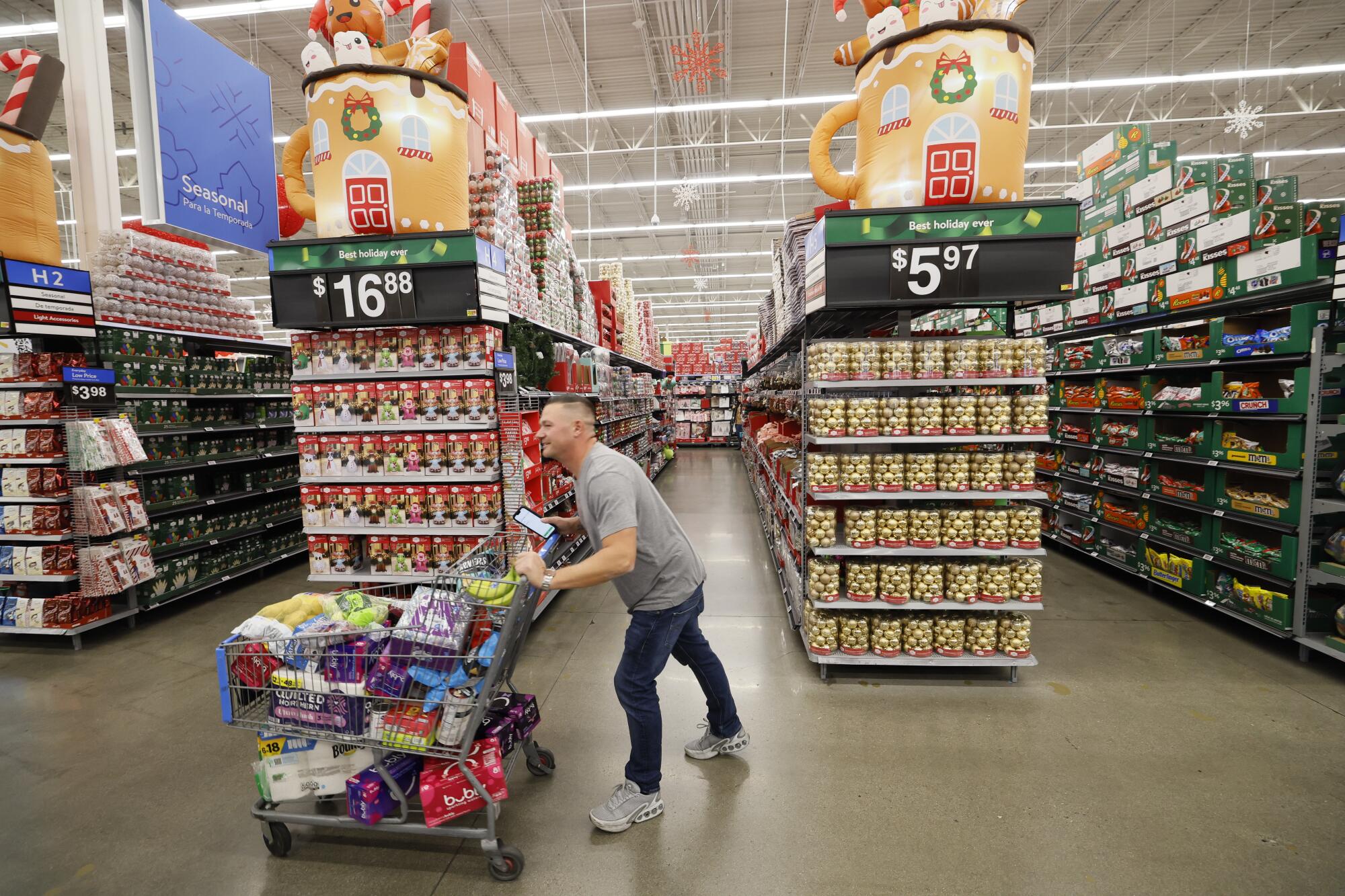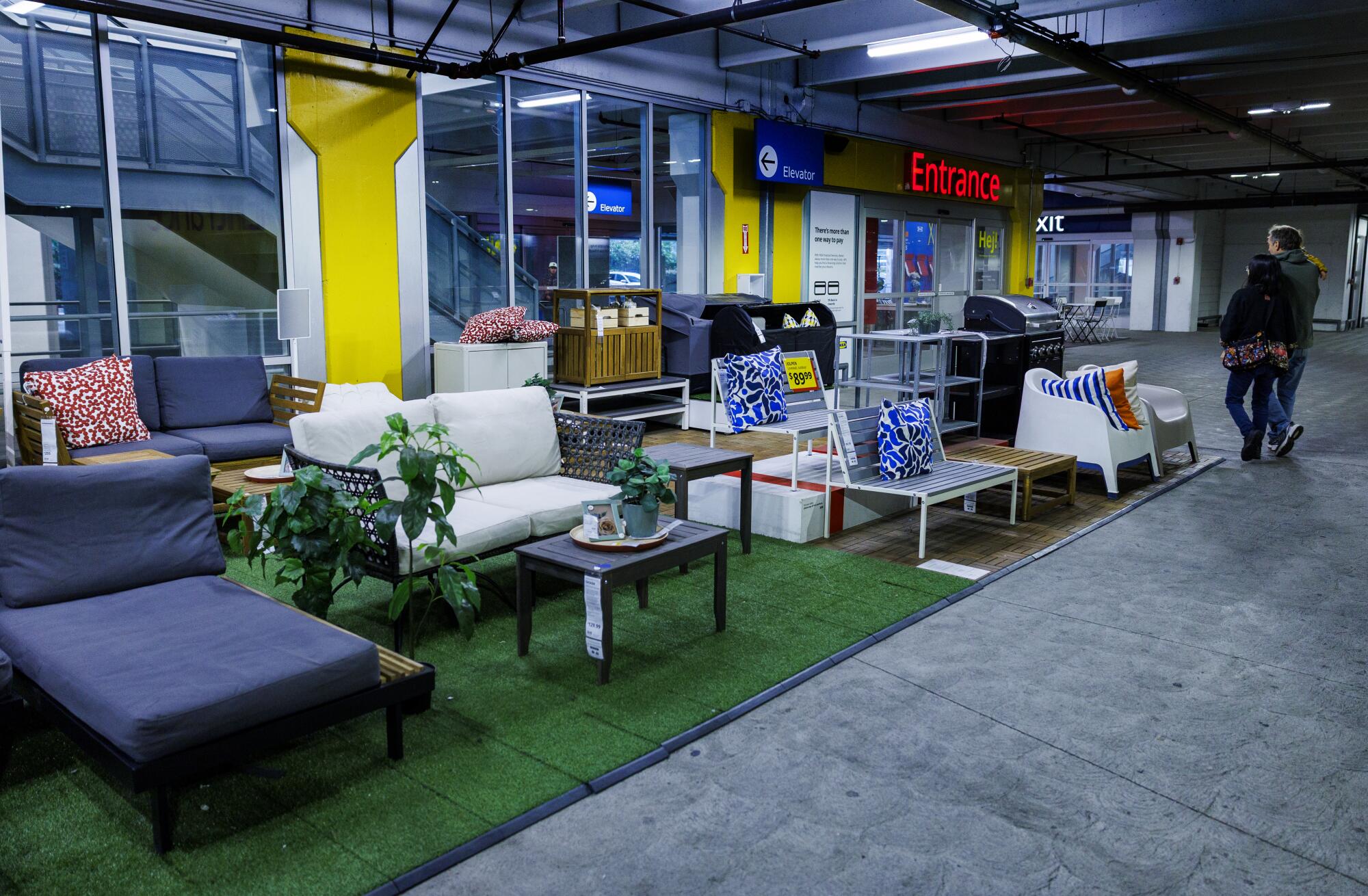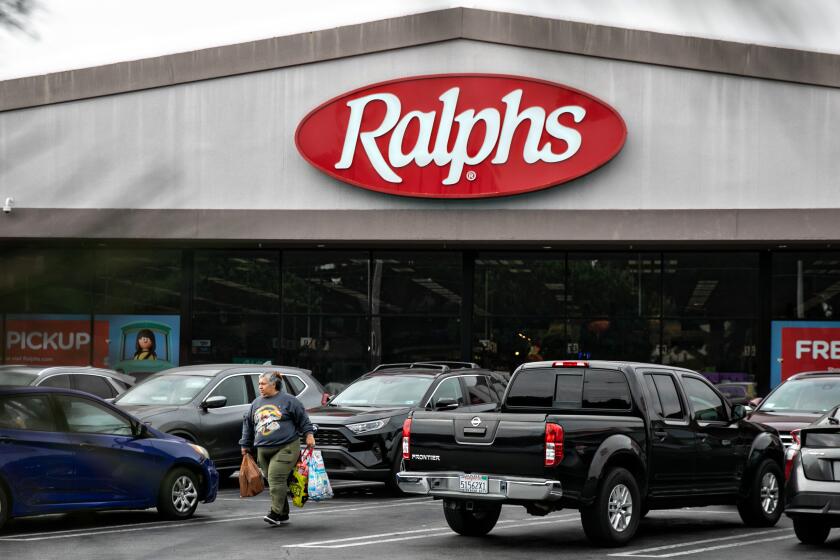
- Share via
Walmart, the nation’s largest retailer known for affordability, announced it would be raising prices, providing the clearest signal to date of the effects of President Trump’s steep tariffs on U.S. shoppers.
In an earnings call on Thursday, executives for the retail giant told industry analysts that an increase in prices would be unavoidable in the face of the highest import duties the U.S. has seen since the 1930s.
Goods including vegetables and furniture will see a jump in price, executives said, a trend that will worsen in July when back-to-school shopping begins. Car seats made in China could increase in price by $100, the company said.
The Trump administration says it intends to develop a ‘mechanism’ that will ‘rebalance’ the U.S. trade relationship with China — a task that has eluded presidents for decades.
“We’re wired to keep prices low, but there’s a limit to what we can bear, or any retailer for that matter,” Walmart Chief Financial Officer John David Rainey told the Associated Press.
Like other businesses, the company didn’t give an outlook for its earnings, reflecting uncertainty in the economy.
Walmart is just the latest retailer and major U.S. company to announce price increases related to the tariffs and trade war with China. Others include consumer products giant Procter & Gamble and Ford, which said it would raise prices on some of its vehicles.

Mattel Inc., the El Segundo-based maker of Barbie and Hot Wheels cars, also announced that it would have to boost prices to offset higher costs from tariffs, prompting a fierce response from Trump, who recently threatened to “put a 100 percent tariff” on the company’s toys.
Trump imposed a universal 10% tariff last month, in addition to a 145% duty on Chinese goods. The latter was cut to 30% in a deal announced this week.
Despite the China deal and several tariff pauses, the cost of producing items such as strollers and spices has rapidly increased since Trump’s so-called Liberation Day. The situation for consumers has worsened as businesses have passed production costs down to their customers.
So far, the effects on shoppers have been minimal. Consumer spending rose a scant 0.1% in April, the Commerce Department said Thursday. It’s a marked slowdown after a 1.7% increase in March, which economists attributed to panic-purchasing ahead of the tariffs.
At a Walmart in South Gate last week, anxious shoppers took advantage of low prices in anticipation of rising costs.
Leora, who lives near USC and declined to share her last name out of privacy concerns, exited the store with a cart overflowing with toilet paper, paper towels and food items.
“I haven’t seen the prices go up yet, but I’m worried,” Leora said. “That’s why I bought so much stuff today.”
Like many small businesses, American chocolate maker Guittard is bracing for the coming impacts of Trump’s tariff war, but unlike some industries, the company is totally reliant on imports.
Other L.A.-area shoppers said they were already beginning to feel the trickle-down effects of the tariffs.
Artesia resident Amol Chitte was looking to update his home closet storage when he visited Ikea’s Carson location in early May. Chitte recently welcomed a baby, he said, and he needed somewhere to store baby clothes and other newborn supplies.

The software engineer said sticker prices were double and even triple the $100 he’d budgeted for the purchase. The items seemed more expensive than they were at this time last year, he said.
“I was surprised how expensive the furniture was,’’ he said. “If I go to a budget store like Walmart, I would find something more reasonable.”
A representative for Ikea did not respond to a request for comment.
Experts say tariffs will affect everyday purchases, but as negotiations continue, exact price increases remain unclear.
Jesper Brodin, chief executive of the Ingka Group, which operates the majority of Ikea stores globally, told CNN in November that “tariffs make it more difficult for us to maintain the low prices and be affordable for many people, which in the end is our goal.”
Ikea is not the only business struggling with how to respond to rising costs of operation, said Dominick Miserandino, a retail and consumer analyst and CEO of Retail Tech Media Nexus.
These businesses have to do what they can to remain profitable, Miserandino said, but ultimately, raising prices is “never a good look.”
“If you’re raising prices and your competitors are not, the fallout is much worse than the profit gain,” he said.
The reluctance of business owners to hike prices in the absence of certainty regarding Trump’s tariffs may explain in part why a spike in inflation has yet to appear in national retail data.

Inflation slowed for the third consecutive month in April, when consumer prices rose 2.3% from a year ago, the Labor Department said Tuesday, although inflation was higher in the Los Angeles region during the same period.
The Consumer Price Index was up 3% in April in the L.A.-Long Beach-Anaheim region, driven mainly by higher costs for housing, medical care and food and beverages, according to Labor Department data examined by The Times.
Manisha Goel, an associate professor of economics at Pomona College, attributed the discrepancy to California’s housing crisis, which has driven up property values and thereby boosted regional inflation.
But the relatively modest inflation rates aren’t expected to last.
Economists said consumers in Southern California can count on steeper price increases on a range of products — dolls, chocolate,household appliances — in the coming months as the full effects of Trump tariffs take effect.
Niree Kodaverdian, a research manager at L.A. economics consulting firm Beacon Economics said that products with imported parts such as electronics will rise in price most quickly, whereas “for things that we have a lot of inventory for, we’re not going to see price effects right away.”
The researcher also noted that CPI data takes into account a high number of non-imported products, such as airplane tickets.
“The CPI is not necessarily putting extra weights on import-heavy products that consumers are buying,” Kodaverdian said, so the data could be underplaying the impact of the tariffs.
Further, she said, businesses may be holding out on increasing prices until they know the tariffs are here to stay.
Lee Ohanian, an economics professor at UCLA, suspects the U.S. will be able to reach agreements with other countries to keep potential tariff disruptions at a minimum.
“I’m optimistic that this is getting all worked out,” Ohanian said, adding that “everybody loses in a tariff war, and other countries are relatively bigger losers from this than we are.”
Trump’s worldwide tariffs are putting the squeeze on several high-profile L.A.-based toy makers and apparel companies.
“The best-case scenario is that the tariff war is resolved and that we don’t see a burst of inflation in May,” the economist said. If not, he projected the price hikes would be visible in consumer data by June.
Thus far, it’s been difficult to gauge the impacts of the tariffs on prices, Ohanian said, but California seems to be hurting disproportionately because of its high property prices and relatively higher-priced groceries.
CPI data showed meat products such as sirloin steak and sliced bacon were more expensive in the western United States, compared to the country as a whole, in April. The higher sticker prices could be a result of California’s high food standards and humane animal requirements, Ohanian said.
As American consumers anticipate steep price hikes on essentials and discretionary goods due to the tariffs, their expectations for the future are at a 13-year low, according to the Conference Board’s Consumer Confidence Index.
Consumer confidence has seen similar — albeit not quite as severe — lows before, especially in periods of global turmoil, said Stephanie Tully, an associate professor of marketing at USC’s Marshall School of Business.
During the COVID-19 pandemic, American consumer confidence saw its steepest drop since the 2008 recession as unemployment and market volatility rose while household income and consumer spending fell. Public sentiment recovered relatively quickly, even despite high inflation, but Tully doesn’t expect that to happen this time around.
“In the past, people had more faith that governments and other systems were working to alleviate those things as quickly as possible,” Tully said. Now, with the government contributing to the instability, they don’t know when or from whom to expect relief.
Business owners across Los Angeles who rely on imported goods are bracing for higher prices as Trump imposes steep taxes on products from several countries.
Consumers are coping via some common money-saving behaviors, the researcher said, such as shopping at budget stores or eating out less.
Foot traffic at warehouse stores increased in the weeks before Trump’s tariffs went into effect, and again when reciprocal tariffs were poised to hit before a 90-day pause, according to recent data from analytics platform Placer.ai.
But without income increases to counter rising costs or any sense of permanence to the tariffs causing them, people may struggle to adapt to their new financial realities.
“Those consumers are going to be feeling [the strain] for years and years to come, probably without really getting used to it,” Tully said.
The Associated Press contributed to this report.
More to Read
Inside the business of entertainment
The Wide Shot brings you news, analysis and insights on everything from streaming wars to production — and what it all means for the future.
You may occasionally receive promotional content from the Los Angeles Times.


















